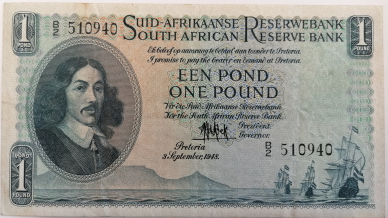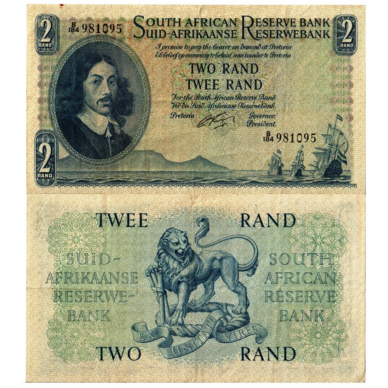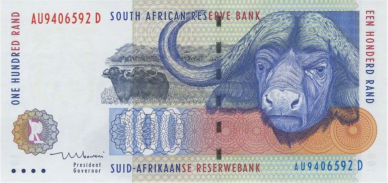The South African Rand

The South African Rand (R, ZAR)
The South African Rand (R, ZAR) is the currency used for internal payments within the territories of the Republic of South Africa, Lesotho, and Swaziland, which have formed their own monetary area with a uniform legal tender. The rand also circulates in Namibia.
It is also included in the list of CLS currencies because South Africa has been the IMF member state since 1945. As a result, the South African rand is also a fully convertible currency.

History
The rand’s predecessor was the rixdollar - a peculiar currency of the first Dutch colony Kaapstad, which was founded in 1652 and occupied the territory of the modern RSA. Initially, the rixdollars were silver coins stamped with a high-quality hallmark and minted by the East-Indian company.
Gradually, the hallmark quality was decreasing, and the exchange rate was falling. The deficit of coins at the end of the 18th century was the reason why governor Joachim van Plettenberg initiated the issuance of paper notes. Interestingly, they were not printed but handwritten as obligations and approved with the governor’s seal. The first banknotes were issued in 1782.
At the beginning of the 19th century, Kaapstad’s jurisdiction changed, and the British Empire became the city’s sovereign. Those changes brought new money: the British pound became legal tender in 1826. Since that time, it began its circulation within the other territories of the African south along with the other means of payment.
It was 1922 when South Africa first obtained its own currency after Kaapstad, the Orange Free State, Natal, and Transvaal had created the Union of South Africa. The South African pound was immediately pegged to the British currency with an exchange rate of 1:1, which remained the same during the entire existence of the Union from 1921 to 1961.

The South African pound
The rand was introduced in 1961 after the creation of the South African Republic. That was necessary for the transition of a new country to the easy-to-use decimal system.
The rand got a fixed peg to the two world currencies - the British pound and the US dollar - with the exchange rates of 2:1 and 1.4:1 respectively. That ratio remained for 20 years while the rand maintained its stability.

South Africa Rand (1961-1965)
In 1982, the economic situation in South Africa began deteriorating, which entailed a drastic depreciation of the national currency. The falling of the exchange rate continued till the beginning of the 21st century. In 2001, it was 13.8:1. Gradually, the South African currency has strengthened, and now the ratio with the US dollar is around 7:1.
Design
The first issuance of the RSA money took place in 1961. The coins were minted in denominations from 0.5c to 50c, and the R1, R2, R10, and R20 banknotes were printed. The fractional coin of 0.5c was last issued in 1983, and the R1 coin - in 1977.
At the beginning of the 2000s, the RSA refused from 1c and 2c coins, and in 2004 they minted the R5 coins, the distinctive feature of which was a grooved edge as a security feature to protect metallic money from counterfeiting. In 2005, the banknotes of the same denomination were issued.

Design Series
The first series of paper money of a new country was released in 1961: the notes of R1, R2, R10, and R20. Their design was similar to the design of the British pounds, and the obverse of each note featured the portrait of Jan van Riebeeck - the founder of the first Dutch colony on the African south.
The inscriptions were made in English and Afrikaans. In five years, the banknote in the largest denomination of 20 rand was withdrawn from circulation, but a new 5-rand note emerged instead.
In 1978, a new series with the R2, R5, and R10 notes was released. Then in 1984, the notes in large denominations of R20 and R50 appeared. There were the minimum design changes, and they related only to the order of inscriptions in English and Afrikaans. All the notes featured the portrait of Jan van Riebeeck.
The design of the South African currency changed considerably only in the 1990s. The images of safari animals like elephants, rhinoceros, cape buffaloes, lions, and leopards appeared on the obverse. The banknotes in large denominations of R100 and R200 were also issued.

100 South Africa Rand banknote (1994)
Since 2012, the obverse of the new series of banknotes has depicted the portrait of the first Black President of the Republic of South Africa Nelson Mandela. There are five denominations - R10, R20, R50, R100, and R200.
2012 Sixth Issue Banknotes
- 10 rand is a green banknote that measures 128 mm by 70 mm and features a rhinoceros on the reverse
- 20 rand is a brown banknote that measures 134 mm by 70 mm and features an elephant on the reverse
- 50 rand is a red banknote that measures 147 mm by 70 mm and features a lion on the reverse
- 100 rand is a blue banknote that measures 147 mm by 70 mm and features a cape buffalo on the reverse
- 200 rand is a blue banknote that measures 152 mm by 70 mm and features a leopard on the obverse.
2018 Seventh Issue Banknotes
The latest issue of the banknotes is entirely devoted to the first RSA President. The obverse, as in the earlier years, features his portrait. The reverse depicts the episodes from Nelson Mandela’s life and landmarks related to him. Though the size of the banknotes has remained the same, there has been some colour change:
- 10 ZAR - the banknote depicts the portrait of young Nelson Mandela and his native town of Mvezo on the reverse
- 20 ZAR - the banknote features the President’s home in Soweto
- 50 ZAR - the banknote shows the portrait of young Nelson Mandela and the place of his arrest - Howick
- 100 ZAR - the banknote depicts the portrait of a young President and the place of his imprisonment - Robben Island
- 200 ZAR - the banknote features young Nelson Mandela and his statue
The banknotes are issued by the South African Reserve Bank, and the coins are minted by the South African Mint.

ZAR in the World
The Republic of South Africa is a country with enormous gold and diamond reserves, which makes it a huge exporter of raw materials for the global jewellery industry. This peculiarity of the RSA economics has a direct impact on the rand exchange rate because the demand for metals and jewels is constantly changing. So a fluctuating exchange rate has been set.
The rand is traded on the Forex exchange being one of the most popular currencies.







